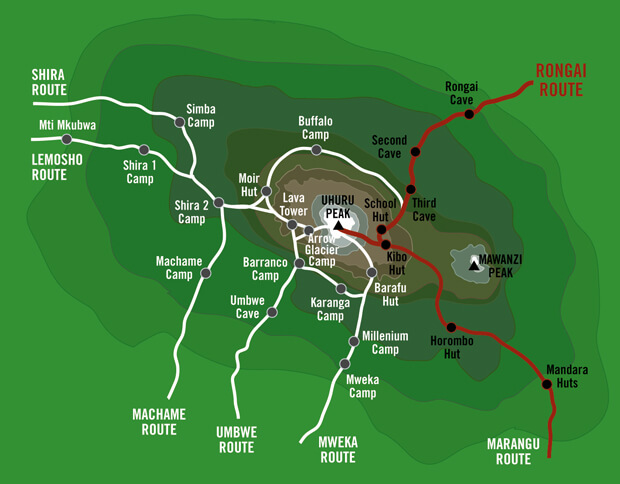Day 1: Rongai Gate (1,950m) to Simba Camp (2,650m)
Hiking time: 4–5 hours
Distance: 8 km
Weather: Warm and humid in the forest zone, with possible showers.
Acclimatization: Gradual ascent begins; go slow to help your body adapt.
Your adventure starts with registration at Marangu Gate before a short transfer to Rongai Gate on the northern slopes of Kilimanjaro, near the Kenyan border. The trail climbs gently through farmland and pine forest before entering lush montane forest. You may spot monkeys and colorful birds before reaching Simba Camp for your first overnight stay.
Day 2: Simba Camp (2,650m) to Second Cave Camp (3,450m)
Hiking time: 5–6 hours
Distance: 9 km
Weather: Cooler, with bright sun in open areas and cold nights.
Acclimatization: Noticeable altitude gain; keep hydrated and pace yourself.
Leaving the forest, you enter heathland with open views of the plains below and Mawenzi Peak rising sharply ahead. The path is steady and less steep, making it easier for acclimatization. Tonight’s camp is at the Second Cave, where you’ll enjoy wide horizons and starlit skies.
Day 3: Second Cave Camp (3,450m) to Kikelewa Camp (3,600m)
Hiking time: 4–5 hours
Distance: 6 km
Weather: Sunny during the day; evenings turn cold quickly.
Acclimatization: Gentle gain in altitude helps with gradual adjustment.
The route winds across moorland with patches of giant heather and other unique alpine vegetation. Views of Mawenzi Peak become more dramatic as you approach camp. Kikelewa Camp sits in a sheltered valley with stunning scenery and is perfect for acclimatization.
Day 4: Kikelewa Camp (3,600m) to Mawenzi Tarn Camp (4,330m)
Hiking time: 4–5 hours
Distance: 6 km
Weather: Cold and windy; occasional frost at night.
Acclimatization: A significant climb; rest and hydration are crucial.
A short but steep climb takes you up grassy slopes with rewarding views behind you. Soon you enter the alpine desert zone with sparse vegetation. You’ll camp at Mawenzi Tarn, situated beneath the jagged spires of Mawenzi Peak—one of the most dramatic campsites on Kilimanjaro.
Day 5: Acclimatization Day at Mawenzi Tarn (4,330m)
Activity: Day hikes and rest.
Weather: Bright and clear but cold, especially in the evening.
Acclimatization: Essential rest day to improve summit success.
This day is dedicated to acclimatization. You’ll take short hikes around Mawenzi Tarn, climbing higher and returning to camp to sleep low. The extra day greatly increases your chances of a safe and successful summit.
Day 6: Mawenzi Tarn (4,330m) to Kibo Hut (4,700m)
Hiking time: 5–6 hours
Distance: 8 km
Weather: Dry, cold, and windy in the alpine desert.
Acclimatization: Final preparation before summit push.
The trail crosses the lunar-like alpine desert known as the “Saddle” between Mawenzi and Kibo peaks. It’s a stark, dramatic landscape with little vegetation. By afternoon you’ll reach Kibo Hut, your base camp for the summit attempt. Rest early and prepare for the midnight climb.
Day 7: Kibo Hut (4,700m) to Uhuru Peak (5,895m), then down to Horombo Hut (3,720m)
Hiking time: 11–14 hours
Distance: 19 km
Weather: Freezing before dawn (-10°C to -20°C), with clear skies at sunrise; warmer on descent.
Acclimatization: The ultimate test of endurance and adaptation.
Summit night begins around midnight with a steep, slow climb to Gilman’s Point (5,685m) on the crater rim. From there, continue along the ridge to Uhuru Peak, the highest point in Africa. After celebrating your achievement, descend back to Kibo Hut for rest, then continue down to Horombo Hut for the night.
Day 8: Horombo Hut (3,720m) to Marangu Gate (1,870m)
Hiking time: 5–6 hours
Distance: 20 km
Weather: Warmer and humid as you re-enter the rainforest.
Acclimatization: Rapid descent eliminates most altitude effects.
The final trek descends steadily through moorland and lush forest, where you may spot monkeys and tropical birds. At Marangu Gate, you’ll receive your summit certificate before saying farewell to your mountain crew and transferring back to your hotel.

